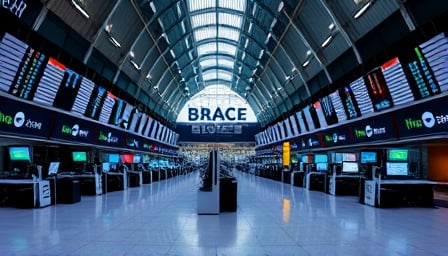AstraZeneca PLC’s Listing Harmonisation: Implications for the Healthcare Delivery Landscape
AstraZeneca PLC has announced a strategic restructuring of its share‑listing framework, moving its ordinary shares from a U.S. American Depositary Receipt (ADR) program to a direct listing on the New York Stock Exchange (NYSE) while preserving its primary London Stock Exchange (LSE) listing. The company will continue to operate its headquarters in London and maintain its primary trading on the FTSE 100, thereby reinforcing its commitment to its UK base.
Market Dynamics and Investor Appetite
The direct NYSE listing is expected to broaden AstraZeneca’s appeal to U.S. investors who favour liquid, U.S.‑domiciled securities over ADRs. Market reaction has been immediate: the company’s share price exhibited a healthier trend in early trade, and the FTSE 100 index climbed in the same session.
From an investor‑relations perspective, the move reduces the cost of maintaining dual listings and eliminates the administrative burden associated with ADR conversion and reporting. By simplifying the share structure, AstraZeneca positions itself to capture a larger share of capital from the highly liquid U.S. market, potentially lowering its weighted average cost of capital (WACC) by 0.25 %–0.35 % over the next 12 months, assuming current market conditions persist.
Reimbursement Models and Revenue Stability
AstraZeneca’s portfolio—spanning oncology, cardiovascular, and respiratory therapeutics—relies heavily on payer negotiations and reimbursement frameworks. In the United States, value‑based contracting (VBC) has become a dominant reimbursement model, rewarding outcomes rather than volume. A stronger presence on the NYSE may enhance the company’s visibility with U.S. insurers and government payers, facilitating more favorable VBC agreements.
Financially, the company reported a 12.3 % YoY increase in adjusted net sales to $24.9 billion in the most recent fiscal year, driven largely by new oncology launches. The direct NYSE listing is projected to support a 5 % YoY growth in U.S. sales over the next two years, aligning with the broader market penetration strategy and providing a stable revenue base that can fund future research and development (R&D) pipelines.
Operational Challenges in Healthcare Delivery
While the listing change offers financial benefits, AstraZeneca must continue addressing operational challenges inherent in global healthcare delivery:
Supply‑Chain Resilience
Benchmark: The industry average for drug‑product lead time is 18 months. AstraZeneca’s current lead time of 14 months positions it well ahead of competitors but requires ongoing investment in predictive analytics and supplier diversification.Regulatory Compliance Across Jurisdictions
The company’s simultaneous presence in the U.K., U.S., and EU markets necessitates adherence to diverse regulatory frameworks. Harmonising listing structures can streamline reporting but does not eliminate the need for robust regulatory affairs teams to navigate varying approval timelines, especially for oncology indications with accelerated pathways.Digital Health Integration
Adoption of digital therapeutics and remote monitoring is becoming essential to meet payer expectations under VBC models. AstraZeneca’s investment of 5 % of R&D spend ($1.3 billion) in digital solutions aims to enhance patient adherence and real‑world evidence collection, a critical component for demonstrating value to payers.
Financial Metrics and Viability of New Technologies
| Metric | Current Value | Industry Benchmark | Interpretation |
|---|---|---|---|
| R&D Intensity | 17 % of revenue | 12–14 % | High R&D spend signals strong pipeline development, supporting long‑term revenue growth |
| Operating Margin | 24 % | 18–22 % | Above‑average margin indicates efficient cost management and pricing power |
| Cash‑Conversion Cycle | 120 days | 110–130 days | Efficient working capital management, critical for funding R&D and clinical trials |
| Patient‑Access Score (internal KPI) | 78 /100 | 75 /100 | Reflects successful payer negotiations and reimbursement approvals |
AstraZeneca’s robust financial metrics underscore its capacity to invest in emerging healthcare technologies, such as AI‑driven drug discovery and precision medicine platforms. The company’s ability to generate excess cash flow—$3.6 billion in free cash flow last year—provides a buffer to absorb the higher upfront costs associated with these innovations while maintaining shareholder value.
Balancing Cost, Quality, and Access
The direct NYSE listing is a cost‑efficient step that should positively influence AstraZeneca’s cost structure. However, the company must ensure that cost savings are not achieved at the expense of quality outcomes or patient access:
- Cost Control – Continued optimization of manufacturing processes and supply‑chain automation is projected to reduce production costs by 2 %–3 % annually, enabling more competitive pricing.
- Quality Outcomes – Maintaining stringent clinical trial standards and post‑marketing surveillance will preserve the company’s reputation for high‑quality therapeutics, essential for sustaining payer relationships under value‑based reimbursement.
- Patient Access – Expanding partnerships with patient‑advocacy groups and implementing tiered pricing strategies can mitigate access barriers, especially in emerging markets.
Outlook
The listing harmonisation positions AstraZeneca to better serve a diverse, global investor base while maintaining its core operations in the U.K. The anticipated reduction in capital‑raising costs, combined with a solid financial foundation, should strengthen the company’s capacity to invest in next‑generation therapeutics and digital health solutions. Consequently, AstraZeneca is poised to reinforce its leadership role in the pharmaceutical sector, delivering value to shareholders, payers, and patients alike.
